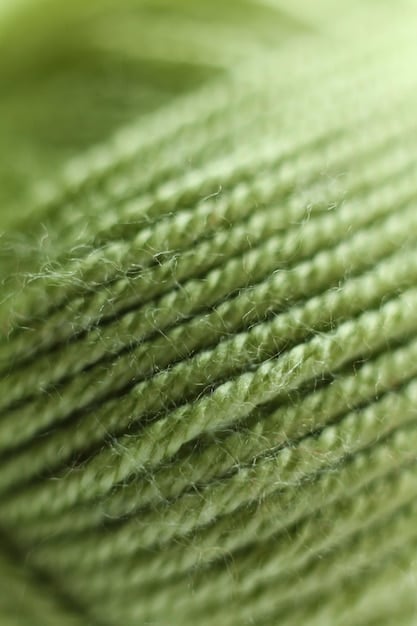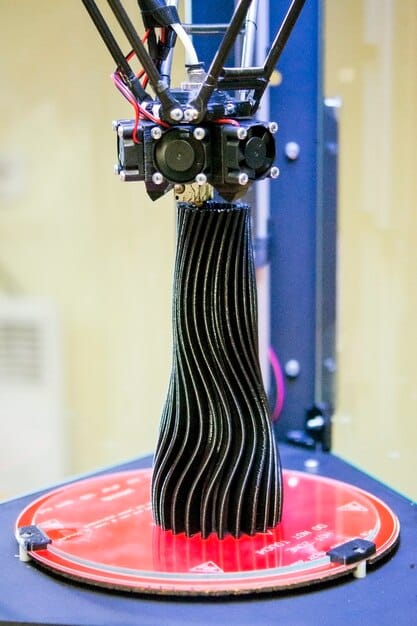The Future of Streetwear: 3D-Printed Apparel & Sustainable Fabrics Revealed

The future of streetwear is fundamentally reshaped by revolutionary 3D-printed apparel and sustainable fabrics, setting new benchmarks for design, production, and environmental responsibility within the fashion industry.
In a world where fashion rapidly evolves, The Future of Streetwear: 3D-Printed Apparel and Sustainable Fabrics stands as a beacon of innovation and responsibility. This isn’t just about new designs; it’s a paradigm shift in how clothing is conceived, made, and experienced.
The Dawn of 3D-Printed Streetwear
The concept of 3D-printed apparel, once confined to science fiction, is rapidly transitioning into a tangible reality within the streetwear domain. This revolutionary technology redefines traditional manufacturing processes by enabling direct digital-to-physical creation.
From custom sneakers to intricate outerwear, 3D printing offers unparalleled design freedom, allowing for complex geometries and textures previously impossible with conventional textile production. It represents a significant leap towards hyper-personalized fashion, tailored precisely to individual body scans and aesthetic preferences.
Redefining Customization and Aesthetics
One of the most compelling aspects of 3D-printed apparel is its inherent ability to deliver unprecedented levels of customization. Designers are no longer restricted by flat patterns or standard weaving techniques; they can sculpt garments directly, adding layers of dimension and detail.
- Personalized Fit: Garments can be 3D-printed to exact body measurements, eliminating standard sizing issues and enhancing comfort.
- Intricate Designs: Complex lattice structures, flexible meshes, and unique textures become feasible, offering novel aesthetic possibilities.
- Rapid Prototyping: Designers can quickly iterate and test new designs, significantly shortening the development cycle from concept to tangible product.
This level of precision not only elevates the wearer’s experience but also opens new avenues for artistic expression in streetwear. Imagine apparel that moves and adapts with the body in unprecedented ways, blurring the lines between fashion, art, and technology.
Technological Advancements and Material Innovations
The progression of 3D printing in fashion is intrinsically linked to material science breakthroughs. Early applications often relied on rigid plastics, limiting wearability. However, ongoing research is yielding more flexible, durable, and comfortable filaments.
Materials such as thermoplastic polyurethanes (TPUs) and various bio-based polymers are becoming increasingly viable. These advancements pave the way for garments that are not only form-fitting but also exhibit properties like water resistance, breathability, and even integrated electronic functionalities.
The convergence of material science with digital fabrication promises a future where clothing is not merely worn but actively interacts with its environment and its wearer, ushering in an era of “smart textiles” that look as good as they perform.
As the technology matures, the cost efficiencies of on-demand 3D printing are also becoming more apparent, hinting at a future where localized production reduces supply chain complexities and environmental footprint.
The Rise of Sustainable Fabrics in Streetwear
Beyond technological innovation, the push for sustainability is fundamentally reshaping the streetwear landscape. Consumers are increasingly conscious of fashion’s environmental impact, driving demand for eco-friendly alternatives to traditional materials.
This shift encompasses everything from raw material sourcing to manufacturing processes, aiming to minimize waste, reduce chemical use, and promote ethical labor practices. Sustainable fabrics are no longer a niche; they are becoming a cornerstone of modern streetwear design.
Bamboo and Organic Cotton: Natural Choices
Among the leading sustainable fabric choices, bamboo and organic cotton stand out for their environmental benefits and comfort. Organic cotton is cultivated without synthetic pesticides, fertilizers, or genetically modified organisms, protecting biodiversity and soil health.
Bamboo fabric, derived from a fast-growing and regenerative plant, requires minimal water and no pesticides. Its natural properties include excellent moisture-wicking capabilities, thermal regulation, and a luxuriously soft feel, making it an ideal choice for comfortable and stylish streetwear.
The adoption of these natural fibers signifies a broader commitment within the industry to reduce its dependency on resource-intensive and polluting materials, moving towards a more harmonious relationship with the planet.
Recycled Materials: Circular Economy in Action
Recycled materials play a pivotal role in the circular fashion economy, transforming waste into valuable resources. Post-consumer plastics, like PET bottles, are being ingeniously repurposed into high-quality polyester fabrics, often referred to as rPET.
- Recycled Polyester (rPET): Reduces reliance on virgin petroleum, saves energy, and decreases landfill waste. Often used in outerwear and activewear due to its durability.
- Recycled Cotton: Salvaged from textile scraps and discarded garments, it minimizes the need for new cotton production, saving water and land.
- Recycled Nylon: Increasingly sourced from discarded fishing nets and industrial plastic, offering a durable and sustainable alternative for various apparel items.
These initiatives demonstrate a growing understanding that waste is a design flaw, not an inevitability. By embracing recycled materials, streetwear brands contribute to a system where resources are kept in use for as long as possible, deriving maximum value from them.

Innovative Bio-Materials: Beyond Traditional Fibers
The quest for sustainability also propels innovation in bio-materials, exploring alternatives that go far beyond conventional natural or recycled options. These cutting-edge fabrics often derive from unexpected and renewable sources.
Examples include fabrics made from pineapple leaves (Piñatex), mushroom mycelium (MycoWorks), and even algae. These materials offer unique textures, properties, and a significantly reduced environmental footprint compared to traditional textiles.
While still in nascent stages for mass production, these bio-materials represent the forefront of sustainable textile engineering. They challenge our perceptions of what clothing can be made from, offering exciting possibilities for a truly regenerative fashion industry.
The integration of these innovative bio-materials into streetwear is poised to redefine luxury and value, shifting the focus from scarcity to ingenuity and environmental stewardship.
Synergy: How 3D Printing and Sustainable Fabrics Intersect
The real transformative power for streetwear lies in the synergistic relationship between 3D-printed apparel and sustainable fabrics. These two trends are not isolated but rather complementary forces driving a more responsible and innovative future for fashion.
3D printing inherently supports sustainability by enabling on-demand production, which minimizes waste, inventory, and overproduction. When coupled with filaments derived from sustainable or recycled materials, the environmental benefits are amplified exponentially.
On-Demand Production and Waste Reduction
Traditional fashion often operates on a model of mass production, leading to significant waste from unsold inventory. 3D printing facilitates a shift to on-demand manufacturing, where items are only produced when an order is placed.
- Minimized Overproduction: Reduces the amount of unsold goods that end up in landfills, a major issue in the fashion industry.
- Streamlined Supply Chains: Localized production reduces the need for extensive global shipping, decreasing carbon emissions associated with transport.
- Material Efficiency: Additive manufacturing processes, by design, use only the necessary amount of material, greatly reducing textile waste generated during cutting and sewing.
This lean production model is a game-changer, addressing one of the most pressing environmental concerns associated with fast fashion. It allows brands to be more agile, responsive to consumer demand, and significantly more sustainable.
Recycling and Circularity in 3D Printing
The beauty of many 3D printing filaments is their potential for recyclability. Components or entire garments can theoretically be shredded and re-extruded into new filament, closing the loop on material use.
Imagine a wardrobe where old 3D-printed garments are not discarded but become the raw material for new designs, creating a truly circular fashion ecosystem. This capability aligns perfectly with the principles of a circular economy, minimizing virgin resource extraction and maximizing material utility.
Researchers are actively developing 3D printing materials specifically designed for easy recycling and degradation, ensuring that the end-of-life of a garment is as thoughtfully considered as its creation.
This integration of design for recyclability at the outset positions 3D-printed streetwear as a leader in truly sustainable clothing production, moving beyond mere material choices to encompass the entire product lifecycle.
Challenges and Opportunities on the Horizon
While the future of streetwear with 3D printing and sustainable fabrics appears bright, significant challenges remain. Scaling these technologies for mass adoption, addressing production costs, and educating consumers are critical hurdles.
However, these challenges also present immense opportunities for brands and innovators willing to invest in pioneering solutions and embrace new paradigms. The market for responsible and innovative fashion is growing, driven by a conscious consumer base.
Scaling Production and Accessibility
One of the primary challenges for 3D-printed apparel is moving beyond bespoke, high-end pieces to achieve mass production capabilities at an accessible price point. The speed of printing, the size of print beds, and the cost of specialized filaments are all factors limiting widespread adoption.
Similarly, while demand for sustainable fabrics is rising, ensuring a consistent and affordable supply of these materials, especially innovative bio-materials, requires further investment in research, development, and infrastructure.
Overcoming these scaling barriers will be essential for these technologies to truly transform the mainstream streetwear market, making sustainable and personalized fashion available to a broader audience.
Consumer Perception and Education
Educating consumers about the value proposition of 3D-printed apparel and sustainable fabrics is crucial. Many still perceive 3D-printed items as rigid or uncomfortable, based on early-stage prototypes.

Changing these perceptions through effective storytelling, demonstrating the comfort and aesthetic appeal of advanced materials, and highlighting the environmental benefits will be key to fostering consumer acceptance and demand.
Brands that effectively communicate their sustainability efforts and the innovative nature of their products stand to gain a competitive edge in a market where conscious consumption is becoming increasingly prevalent.
As consumers become more informed, their purchasing decisions will exert more pressure on brands to adopt greener practices, creating a positive feedback loop for sustainable innovation.
The Economic and Social Impact
The shift towards 3D-printed apparel and sustainable fabrics carries significant economic and social implications, potentially revitalizing local manufacturing, creating new job categories, and promoting ethical supply chains.
This transformation is not just about making better clothes; it’s about building a more resilient, equitable, and environmentally sound fashion industry that benefits both people and the planet.
Local Manufacturing and Job Creation
3D printing allows for decentralized, localized production, potentially reigniting manufacturing in regions previously impacted by outsourcing. This proximity to consumers reduces shipping costs and environmental impact, while also creating new, skilled jobs in design, operation, and maintenance of advanced manufacturing facilities.
It opens avenues for small businesses and independent designers to compete with larger corporations, as the barriers to entry for production are significantly lowered with on-demand capabilities.
This localization fosters economic development within communities, promoting a more distributed and robust manufacturing ecosystem for streetwear.
Ethical Supply Chains and Transparency
The focus on sustainable fabrics inherently drives greater transparency and ethical conduct throughout the supply chain. Brands committed to these materials are more likely to scrutinize their sourcing, ensuring fair labor practices and environmentally responsible cultivation or recycling processes.
Consumers, in turn, can have greater confidence in the origins of their clothing, knowing that their purchases support responsible practices rather than contributing to exploitation or environmental degradation.
This increased scrutiny and demand for transparency push the entire industry towards higher ethical standards, benefiting workers, communities, and ecosystems globally.
The emphasis on the entire lifecycle of a garment, from raw material to disposal, encourages a holistic approach to sustainability that encompasses not just environmental but also social responsibility.
Looking Ahead: The Future Wardrobe
Envisioning the future of streetwear, it’s clear that 3D-printed apparel and sustainable fabrics will be inextricably linked, forming the bedrock of a fashion industry that is both technologically advanced and deeply committed to environmental stewardship.
The wardrobe of tomorrow might feature bespoke 3D-printed pieces, perfectly tailored and endlessly customizable, alongside staple items crafted from innovative bio-materials or meticulously recycled textiles. This isn’t a distant fantasy; it’s a rapidly approaching reality.
Integration with Digital Fashion and Metaverse
The growth of digital fashion and the metaverse offers exciting new frontiers for 3D-printed apparel. Designers can create virtual 3D garments that exist solely in digital spaces, allowing for hyper-realistic renderings and virtual try-ons.
This seamless integration between physical and digital fashion means that 3D design skills become even more paramount. A 3D-printed garment could have a corresponding digital twin for virtual appearances, blurring the lines between real and augmented reality experiences.
This synergy creates new revenue streams, enhances brand engagement, and offers a low-impact way to experiment with radical designs before physical production.
Personal Expression and Conscious Consumption
Ultimately, the future of streetwear will be characterized by a profound emphasis on personal expression and conscious consumption. Consumers will seek out garments that not only reflect their individual style but also align with their values.
The ability to have truly unique, customized pieces made with a minimal environmental footprint will become a significant draw. Streetwear will evolve beyond trends, becoming a powerful statement of individuality, innovation, and responsibility.
This evolution promises a more meaningful relationship between consumers and their clothing, transforming every purchase into an act of conscious choice. The future wardrobe will be smaller, smarter, and profoundly more sustainable.
This paradigm shift underscores that the most desirable clothing is not just about aesthetics, but also its story, its impact, and its alignment with a sustainable future.
| Key Aspect | Brief Description |
|---|---|
| 👕 3D Printing | Enables hyper-customization, intricate designs, and on-demand production, significantly reducing waste. |
| 🌿 Sustainable Fabrics | Includes organic cotton, bamboo, recycled materials, and innovative bio-materials for eco-friendly choices. |
| ♻️ Circular Economy | Integration of these trends promotes recycling, waste reduction, and material reusability in fashion. |
| 🌐 Economic Impact | Potential for localized manufacturing, new job creation, and more ethical, transparent supply chains globally. |
Frequently Asked Questions
▼
3D-printed apparel offers unparalleled customization, allowing for garments tailored to exact body measurements and unique design aesthetics. It also enables intricate patterns and structures previously impossible, while facilitating on-demand production that significantly reduces fashion waste.
▼
Organic cotton and bamboo contribute by reducing environmental impact through sustainable cultivation without harmful pesticides or excessive water. They offer natural comfort, breathability, and durability, aligning streetwear with eco-conscious consumer values and promoting a healthier planet.
▼
Yes, many 3D printing filaments, especially thermoplastics like TPU, can be recycled. The concept involves shredding existing garments and re-extruding the material into new filament. This closes the loop on material use, fostering a truly circular fashion ecosystem with minimal waste.
▼
Key challenges include scaling production to meet mass demand, managing the current higher costs of specialized materials and printing technology, and educating consumers about the comfort, durability, and stylistic versatility of these innovative garments. Overcoming these hurdles is crucial for broader market integration.
▼
The trend promotes localized, on-demand manufacturing, potentially revitalizing regional economies and creating skilled jobs. It reduces reliance on complex global supply chains and fosters greater transparency and ethical practices, moving towards a more decentralized and responsible production model in fashion.
Conclusion
The journey into the future of streetwear reveals a vibrant landscape where innovation meets responsibility. The convergence of 3D-printed apparel and sustainable fabrics is not merely a trend; it represents a profound evolution in how we design, produce, and consume clothing. This powerful duo promises a future where style, individuality, and environmental conscientiousness coexist harmoniously, leading to a more customized, efficient, and ethical fashion industry. As these technologies mature, they will undeniably redefine the very essence of streetwear, offering a glimpse into a wardrobe that is both cutting-edge and profoundly sustainable.





